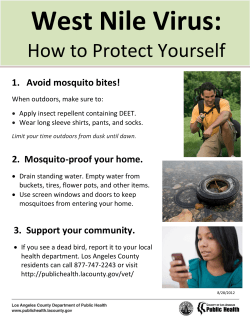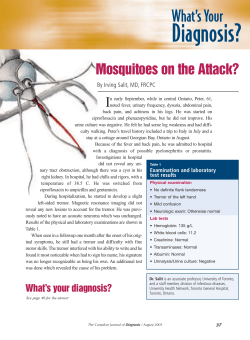
Red runny nose, sore throat and sneezing are the first... of a common cold. To find out what causes it...
Rhinovirus particles Red runny nose, sore throat and sneezing are the first signs of a common cold. To find out what causes it read on... What causes a cold? A cold is a viral infection that is quickly spread from one person to another. There are 200 different viruses which can result in a cold and at least half are caused by the rhinovirus (rhino means nose). In Britain most colds occur during the autumn and winter. The reason for this is when the weather is wet and cold people spend more time indoors in enclosed spaces and it’s easier for the virus to spread from person to person. What are viruses? Viruses are the smallest of all the microbes. The rhinovirus is so tiny that you could line up 50 thousand of them end to end across 1 millimetre. Viruses are unique as they can only exist and multiply inside the living cells of other things (like us). The cell they multiply in is called the host cell. A virus has one aim and that is to make more copies of itself. It does this by sticking to the host cell and invading it. New virus particles are produced inside the host cell. The infected cell bursts and releases virus particles to infect other cells. cell bursts and releases the virus particles virus host cell Viral replication virus multiplies virus invades host cell Cold virus particles being inhaled through the nose and transported to the back of the throat. How do rhinoviruses cause a cold? Fingers contaminated with the rhinovirus when pushed inside and around the nostrils transfer the virus particles into the nose. During the next 10 – 15 minutes the virus particles are transported to the back of the nose and throat where they infect cells lining the surface. Each rhinovirus multiplies inside a host cell. There are now many copies of the virus. The infected cell eventually dies and bursts, releasing the copies of the rhinovirus into the nasal cavity. These new rhinoviruses either infect other cells lining the nose or they are expelled in nasal secretions, for example during a sneeze. They can then go on to start a new infection in another nose. This process takes between 8 and 12 hours. Small doses of virus, 1 – 30 particles, are sufficient to produce an infection. The highest concentration of rhinovirus in nasal secretions occurs during the first 3 days of infection. As a result this is when the person is most contagious. Rhinovirus is excellent at causing infections; when exposed to a strain they had not met before, 95 % of people became infected and 75 % of those infected became ill. Most colds clear up within the week. How are colds spread? Coughs and sneezes expel droplets of mucus-covered rhinoviruses into the air, contaminating the hands of the cold sufferer and also objects and surfaces in their immediate environment. Cold sufferers also get the virus on their hands when they wipe or touch their nose. Rhinoviruses can survive on the skin or on the surface of objects for as long as one day and are easily picked up on the hands of another person who touches them. The viruses cannot multiply but they are still infectious. A study in America has shown that during daily activities adults infected with the cold virus transferred it on average to 35 % of the surfaces they touched and that the virus was easily passed to an uninfected individual whose finger tips touched the contaminated surface. The study also revealed that the most frequently contaminated objects were door handles and pens, followed by light switches, remote controls and taps. Once on the hands, the virus can then be transferred into the nose and eyes by the fingers. Rhinoviruses in the eye are washed down the tear duct into the nose. The infection cycle begins! In some cases the virus may be breathed in directly by another person. A cough or sneeze may cause the virus to land directly in the nose or eye and cause infection. What are the symptoms? Cold symptoms begin 1–3 days after infection. They are: n Runny nose n Sneezing n Coughing n Sore throat n Headache n Mild fever n Blocked sinuses A man sneezing. Can colds be prevented? Since cold viruses can be passed from person to person by hand contact or touching contaminated surfaces such as door handles, the simplest and most effective way to prevent the spread of rhinovirus is frequent hand washing, particularly after sneezing and blowing the nose. This should be done into a disposable tissue, which can be immediately thrown away. Not touching the nose and eyes, as well as avoiding people who are at the beginning of a cold also helps. Why do we get fewer colds as we get older? A new baby gets temporary immunity from its mother, which protects it from many microbial infections including the cold virus. This temporary immunity lasts for about 6 months. It is estimated that each year adults suffer 2 – 5 colds and children 6 – 10 colds. Once a person has been infected with a certain strain of cold virus they develop immunity to it. This means a person can only get each cold strain once. Other strains give rise to other colds. As a person gets older they build up immunity to more and more strains of virus. A teenager in bed with a cold. What is she doing wrong? Stop that ‘Rhino’ in its tracks! Aims To demonstrate how colds can be spread from person to person by both direct and indirect contact and how hand washing can reduce the spread. Materials nBody glitter: the gel is acting as the mucus and the glitter as the rhinovirus. nAccess to soap and water. n Pencil n Ruler Method Divide the class into three groups A, B & C. These groups need to remain separate during the practical activity. Take one person from each group and place a blob of glitter gel, about the size of a ten pence piece, into the left hand palm of each of their hands. Get each of the three pupils to pretend to sneeze into their hands. (At this point if you had a cold and had really sneezed into your hands they would be covered with infectious droplets of mucus containing the rhinovirus.) Get the three pupils to rub their hands together (as they often do to ‘remove’ the droplets). Each of the three pupils should show their hands to the class so they can see how the microbes have been spread all over their hands. Each pupil should go back to his or her own group. The pupils from each group should form a line standing in pairs. Group A The person with the glitter on their hands should shake hands with the first pair of pupils at the start of their line. This pair should go onto shake hands with the next pair in their line. Repeat until they get to the end of the line. Group B The person with the glitter on their hands should handle a ruler and a pencil. The ruler should be passed down one line from pupil to pupil and the pencil down the other until they reach the end of the line. Group C The person with the glitter on their hands should go and wash them using soap and water. Then repeat activity as for group A. Each group should examine their hands and describe what they see. After they have completed the activity, bring the pupils back together to discuss their results. Extension activities Ask the pupils to use secondary sources to identify which other diseases may be transmitted by inadequate hand washing. Ask pupils to produce a poster for their peer group, which can be displayed in the hall, showing when they should wash their hands. Useful websites www.commoncold.org www.commoncold.co.uk Picture credits Front cover top, Laguna design/Science Photo Library, Front cover bottom right, Jamie Symonds, Medium Rare p.2, 3D4Medical.com/Getty images, p.3 Upper right, Grapes/Michaud/Science Photo Library, p.3 Bottom, Dave & Les Jacobs/Getty images Wriitten and designed by Dariel Burdass Edited by Janet Hurst Marlborough House, Basingstoke Road, Spencers Wood, Reading RG7 1AG Tel. 0118 988 1802; Email education@sgm.ac.uk © Society for General Microbiology 2009
© Copyright 2025





















